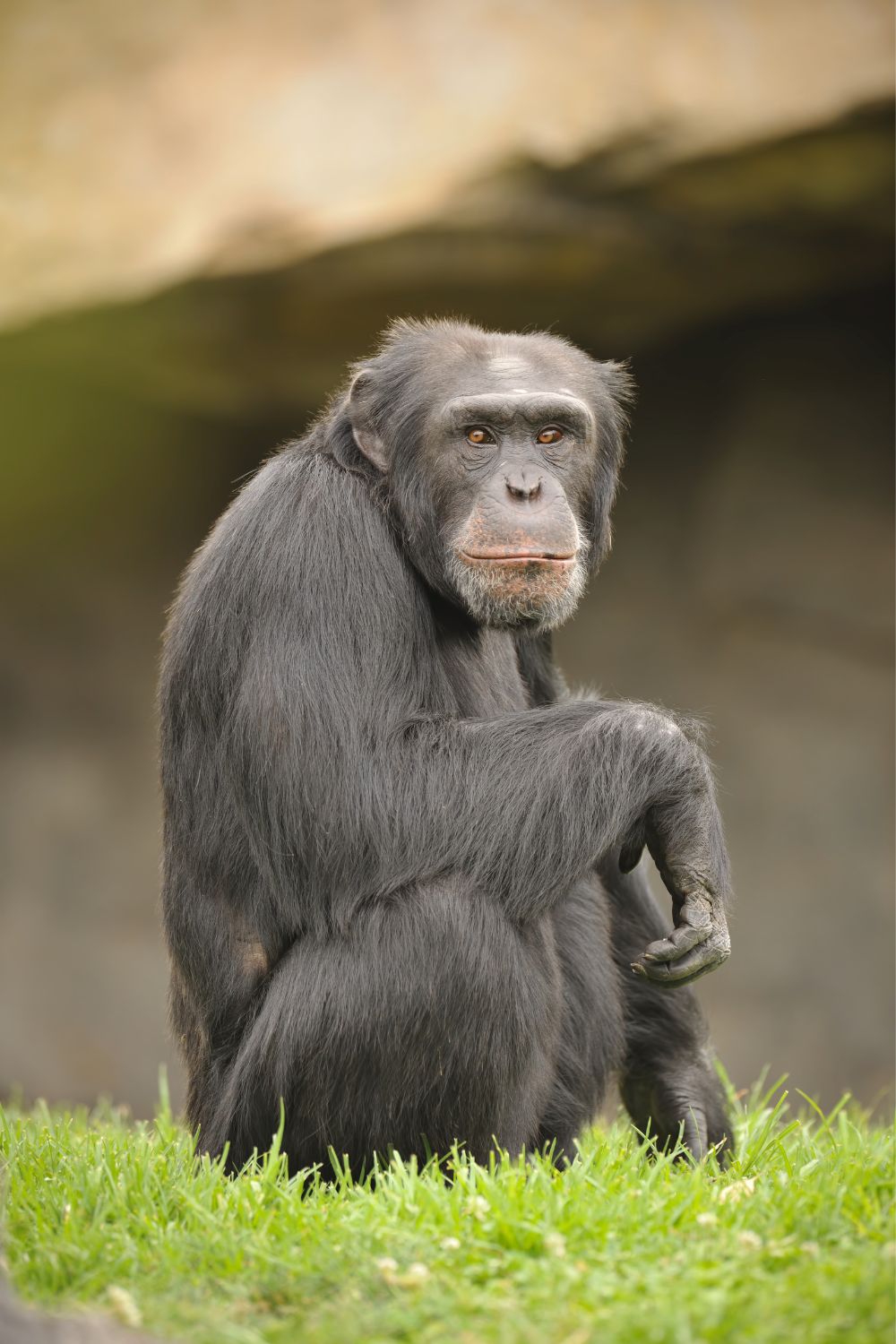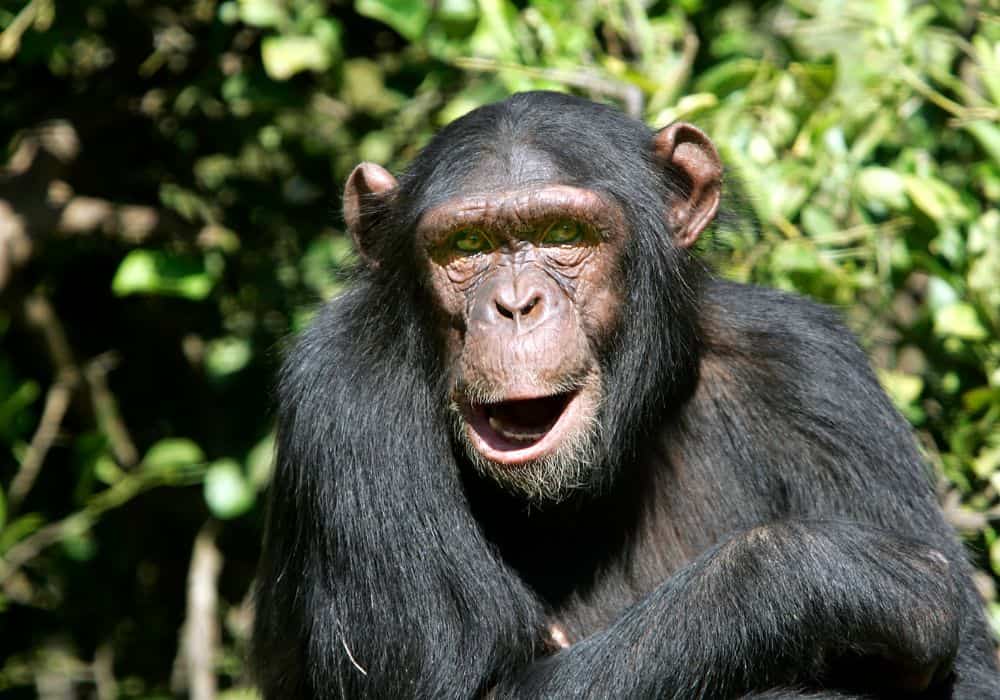Chimpanzees are some of the most intriguing animal species and are famous for their intelligence and human-like behavior. It shouldn’t come as surprise, as chimps are the closest living human relatives, and we’re sharing about 99% of our DNA with these apes.
However, does it make chimps eat similar foods that we’re eating? In this article, we’re going to dive deep into the chimpanzee diet, exploring what, when, and how much they’re eating.
Facts About Chimpanzees
Chimpanzees are one of the great ape species, males growing up to 4 ft 11 in (150 cm) tall and weighing up to 154 lb (70 kg), while females are slightly smaller. They’re incredibly intelligent and social, living in large communities that sometimes approach 150 individual chimps.
Humans split from the last common ancestor with chimpanzees about 5 million years ago. It might sound like a long while ago, but other great apes, like orangutans and gorillas, have split off way earlier than that.
As a result, chimps and humans are sister species, but there are actually several sub-species of chimpanzees:
Central Chimpanzees
This is the second-most populous chimpanzee subspecies, with over 140,000 individuals Inhabiting the Central African Republic, Gabon, and Cameroon. They’re documented to frequently raid the habitat of western lowland gorillas, even killing their juvenile offspring.
Eastern Chimpanzees
This is the most populous chimpanzee subspecies, with estimates ranging from 180,000 to 250,000 individuals living in the wild. They inhabit several countries in Central Africa, including Uganda and Rwanda.
Nigeria-Cameroon Chimpanzees
This is the least populous subspecies, and only several thousand individuals are found in Nigeria and Cameroon. They’re the stockiest subspecies, having the usual weight of up to 154 lb (70 kg), but being the shortest, growing up to 4 ft 3 in (130 cm) tall.
Western Chimpanzees
This is the most divergent chimpanzee subspecies, exhibiting many behaviors and characteristics that haven’t been observed in other subspecies. For example, Western chimpanzees are known to throw rocks at trees for no apparent reason.
There are over 50,000 Western chimpanzees living in the wild, primarily in countries located in West Africa, including Ghana, Senegal, Guinea, and Mali.
Despite some minor differences, all chimpanzee subspecies are very similar and mostly differ by what region of Africa they inhabit. That’s why in this article, we’re going to talk about all subspecies as a whole.
What Do Chimpanzees Eat?
While most people think that chimpanzees are herbivores, they’re actually omnivores, which means that they eat both, plant and animal-based foods.
As a result, they have an incredibly varied diet, and the number of different foods they eat is humongous even when compared to other omnivores.
According to some studies, chimps eat as many as 500 different food items! That’s a much more diverse diet than most of us eat. The exact number and kind of food chimps eat depends on their location. However, here are the main categories of food all chimps eat:
Fruits
Fruits, including apples, bananas, berries, oranges, and mangoes constitute the biggest part of the chimpanzee diet. However, most studies have found that chimps like eating various types of figs, and this single fruit amounts to about half of their total diet.
Plant-Based Foods
Chimps eat basically every type of plant-based food, including roots, stems, leaves, blossoms, seeds, and even bark. These apes are also smart enough to use rocks for cracking kola and panda nuts open, making it possible to eat them.
Insects
Chimps also eat insects, primarily ants, and termites. They sometimes even use sticks as tools to fish these insects out of their nests! However, insects make up just a few percent of their diet.
Animal-Based Food
Insects aren’t the only thing that makes chimpanzees omnivorous. For a long time, chimps were thought to be herbivorous, but in recent decades scientists have recorded chimps eating a wide variety of animal-based foods.
Stuff like honey, bird eggs, and small lizards in chimps’ diet probably isn’t going to shock you, but these primates also actively hunt bigger mammals, including monkeys, antelopes, bushpigs, and even baboons!
Recently, in 2019, scientists recorded a chimpanzee attempting to crack a tortoise open! The chimp was sitting on a tree branch and smashing the tortoise’s shell against it, with hopes to get to its meat.
However, most chimps eat meat about once a month, but there have been recorded cases where chimps nearly hunted some monkey species to extinction.
How Often and How Much Do Chimpanzees Eat?
Chimpanzees usually eat twice a day, once in the morning, and once in the second part of the day. So you could say that chimps have two meals a day, including breakfast and dinner. However, their eating is much more complicated than that.
Eating Bouts
The eating sessions of chimpanzees are much longer than ours, and chimps spend hours every day looking for food and actually eating it. One study found, that an average chimp spends 54.9% of its wake time feeding.
That’s because their eating sessions consist of multiple bouts of eating, each taking anywhere from 1 to 45 minutes. The same study found that an average adult chimp has about 12 such eating bouts every day, eating over 1.2 lb (544 g) of food per bout.
It means that an average chimp eats over 13 lb (6 kg) of food per day. The exact amount of food eaten varies and depends on the food that’s being eaten. Chimps will eat much less calorie-dense foods like nuts and meat compared to food that doesn’t have many calories, like leaves or tree bark.
Food Preferences In Eating Sessions
It’s been noticed that chimps prefer eating fruits early in the morning and shift to munching down on leaves in the afternoon because that’s when they’re more nutritious compared to early in the day.
However, the specific diet varies from day to day, and it’s primarily determined by the availability of the food. If a chimp comes upon a huge termite colony in the morning, it’s going to feast on that, instead of harvesting fruit.
What Are Chimpanzees’ Predators?
Knowing just how intelligent and strong chimps are, it might seem that they’re sitting at the top of their food chain. However, there are several animals that are preying on chimps:
African Leopard
The most widespread leopard subspecies, the African leopard is known to prey on chimps. Not only that but there’s some evidence suggesting that some leopard individuals specialize just in that and that such leopards are the only ones preying on chimpanzees.
African leopards can weigh up to 201 lb (91 kg), are excellent tree climbers, and are equipped with 32 teeth, out of which 4 are long and sharp canines. It makes them one of the only animal species capable of successfully preying on chimpanzees.
Central African Rock Python
This is one of the biggest snake species in the entire world and the biggest in all of Africa. These pythons grow up to 20 ft (6.09 m) long and weigh up to 121 lb (54.88 kg), but there are stories of even bigger individuals.
Central African rock pythons are constrictors, meaning instead of venom, they use constriction as their weapon of choice. The python wraps around its victim and starts squeezing before swallowing it whole. They’re so huge that they can even swallow chimps!
Chimpanzee
That’s right, you’ve read it right, one of the chimpanzee’s natural predators is… the chimpanzee itself! Separate chimpanzee troops are known to engage in violent conflicts, but some of the fights become much more serious than brief skirmishes.
For example, in the 1970s scientists documented the Gombe Chimpanzee War, which lasted over 4 years. It was a long conflict between two clans of chimpanzees that once belonged to the same community.
This war ended in one clan being completely eradicated, and featured organized raids, ambushes, and even kidnappings!
Do Chimpanzees Attack People?
Chimpanzees rarely attack people, and it’s mostly in the form of self-defense arising from humans provoking it. If a chimp feels threatened or thinks that its offspring is in danger, it can become aggressive and attack humans.
However, there have been dozens of documented cases of chimpanzees raiding crops of rural villages in Uganda. In the past 20 years, there have been over 20 documented cases of chimps attacking humans just in the Western Region of Uganda alone.
In one village called Muhororo, chimpanzees have killed three children since 2014. In total, there have been 6 recorded cases of chimps not only kidnapping but also eating human babies.
While our cousins seem like cool animals, they are still wild animals and are incredibly dangerous. However, it’s also worth keeping in mind that it is human activity that’s slowly destroying chimpanzee habitats, pushing these apes away from their natural environments.
Only when chimpanzees lack food and lose their habitat do they roam as far as to reach human establishments, where such tragic cases are known to happen.
Final Words
Our closest living relatives are among the most intelligent extant animal species. It allows them to eat one of the most varied diets, consisting of both plant and animal-based foods.


